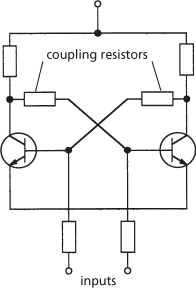An electronic oscillator consisting of two active devices, usually transistors, interconnected in an electrical network. The purpose of the device is to generate a continuous square wave with which to store information in binary form in a logic circuit. This is achieved by applying a portion of the output voltage or current of each active device to the input of the other with the appropriate magnitude and polarity, so that the devices are conducting alternately for controllable periods.
An electronic oscillator that consists of two resistor-capacitor amplifier stages that interact in such a way that the amplifier’s outputs are complementary and exhibit two stable mutually exclusive states, i.e. fully on and fully off. The circuit can be made to oscillate continuously, producing a square wave (astable mode), produce single pulses (monostable mode), or change state on application of an external trigger (bistable mode). See also flip-flop.
An oscillator that contains two linear inverters coupled in such a way that the output of one provides the input for the other. There are several types of multivibrator, the action of which depends on the type of coupling used.
Capacitive coupling produces an astable multivibrator that has two quasi-stable states; once the oscillations are established the device is free-running, i.e. a continuous waveform is generated without the application of a trigger.
Resistive-capacitive coupling produces a monostable multivibrator.
Resistive coupling (see diagram) produces a bistable circuit that has two stable states and can change state on the application of a trigger pulse. See flip-flop.

Bistable multivibrator
- average sample number
- average tax rate
- average velocity
- averaging filter
- Averch-Johnson effect
- Averroës (1126–98)
- Averroës (c.1126–98)
- Averroës (or Abu Al-Walid Muhammad Ibn Ahmad Ibn Rushd)
- averted vision
- Avery, Oswald Theodore
- Avery, Oswald Theodore (1877–1955)
- Aves
- AVHRR
- aviation gasoline
- Avicebron
- Avicenna (980–1037)
- avidin
- avidity((in immunology))
- avidya
- avionics
- Avior
- Avirulence gene
- AVL tree
- AVN
- Avogadro, Amedeo (1776–1856)